How Often to Water Snake Plants: The Ultimate Seasonal Guide

Snake plants (Dracaena trifasciata) are known for tolerating neglect, but they still require water once the soil has completely dried out. These plants adapt to a wide range of indoor and outdoor conditions, but they’ll show signs of stress if their watering needs are not met.
Season, temperature, light, and pot size all affect how often to water snake plants. In general, water only when the top 2 inches of soil are dry to the touch.
Quick Answer: Water snake plants only when the soil is completely dry. Indoors, this is usually every 2–4 weeks in spring and summer, and 4–6 weeks in fall and winter. Always check the top 2 inches of soil — if it feels dry, it’s time to water; if it’s even slightly damp, wait.
Seasonal Snake Plant Watering Schedule
Snake plants do not follow a fixed watering calendar. Their needs change with the environment. Light, temperature, and growth rate all affect how quickly the soil dries.
Last year I thought because my home was fairly cool in winter, watering every 4 weeks would be safe — until the base leaves turned yellow. That taught me to actually check soil moisture, not just calendar.
Use the following table as a general guide, then adjust based on your specific conditions:
| Season | Typical Indoor Frequency | What to Watch For |
|---|---|---|
| Spring & Summer | Every 2–3 weeks | Faster growth, warmer temps, longer days mean quicker drying soil. |
| Fall | Every 3–4 weeks | Growth slows, light decreases — soil stays damp longer. |
| Winter | Every 4–6 weeks or less | Dormant period; cooler temps and low light slow water use. |
| Transitional Periods | Adjust weekly checks | Early spring and late autumn can bring fluctuating temperatures — check soil often. |
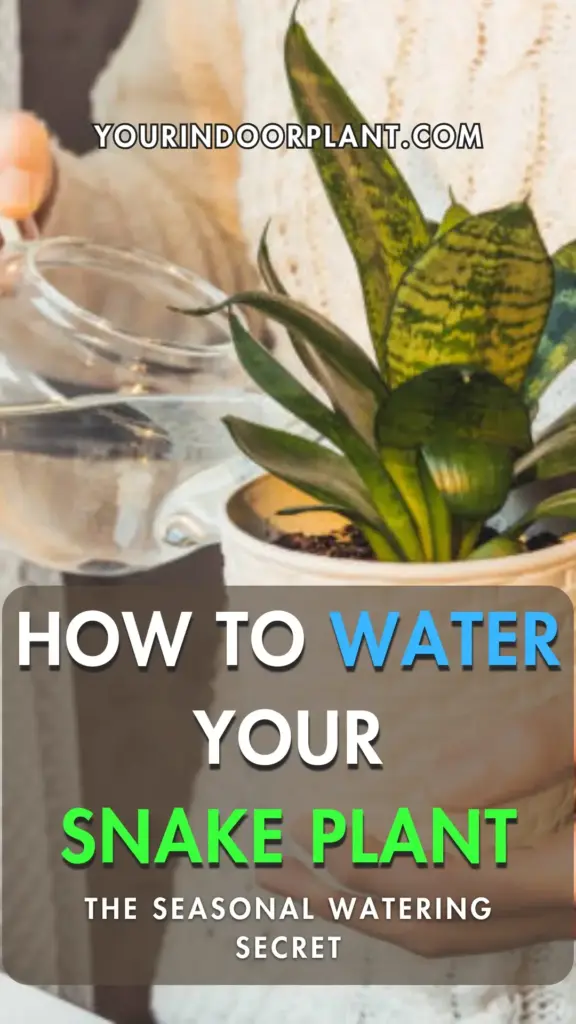
Spring and Summer: During the active growth season, longer days and warmer temperatures cause the soil to dry more quickly. Indoors, check the soil every 10 to 14 days in bright light, or every two to three weeks in moderate light. Outdoor plants in full sun may need water once a week. Always water thoroughly until excess drains from the bottom of the pot, then allow the soil to dry completely before watering again. In spring, my small snake plant in a terra cotta pot needed water every 2 weeks, but my larger one next to it (in plastic pot) only every 3. Same room, same light — pot material made the difference.
Fall: As daylight shortens and temperatures drop, snake plants slow their growth. Check the soil every three to four weeks and reduce watering gradually to avoid stressing the plant. Cooler nights near windows can slow evaporation, so adjust your schedule accordingly.
Winter: Winter is the plant’s rest period. Water every four to six weeks, or less if the soil remains damp. Avoid watering if there is any moisture in the soil, as root rot risk is highest during this time. Keep plants away from cold drafts and heating vents to prevent uneven drying.
Transitional Periods: Early spring and late autumn can bring unpredictable swings in temperature and light. Check the soil weekly, but water only when it is completely dry. If moving a plant outdoors in spring, adjust gradually to brighter light and faster‑drying soil. In late autumn, begin spacing out waterings in preparation for winter dormancy.
Factors That Affect How Often to Water Snake Plants
A snake plant’s watering schedule depends entirely on its growing conditions and environment, as these factors control how quickly the soil dries out.
Light, temperature, humidity, soil type, pot material, and location (indoors vs. outdoors) all affect how often they need water.
1. ☀️ Light Levels
Light is one of the main factors affecting how quickly soil dries. Snake plants in bright, indirect light will need water more often than those in low light or deep shade.
I placed a snake plant near a window with lots of light; despite hues of cooler winter air, it dried much faster than the same species elsewhere in low light. That showed me light exposure + airflow are huge.
Plants grown outdoors in direct sunlight, especially in summer, may require weekly watering. If a plant is moved to a brighter location, expect to water it more frequently.
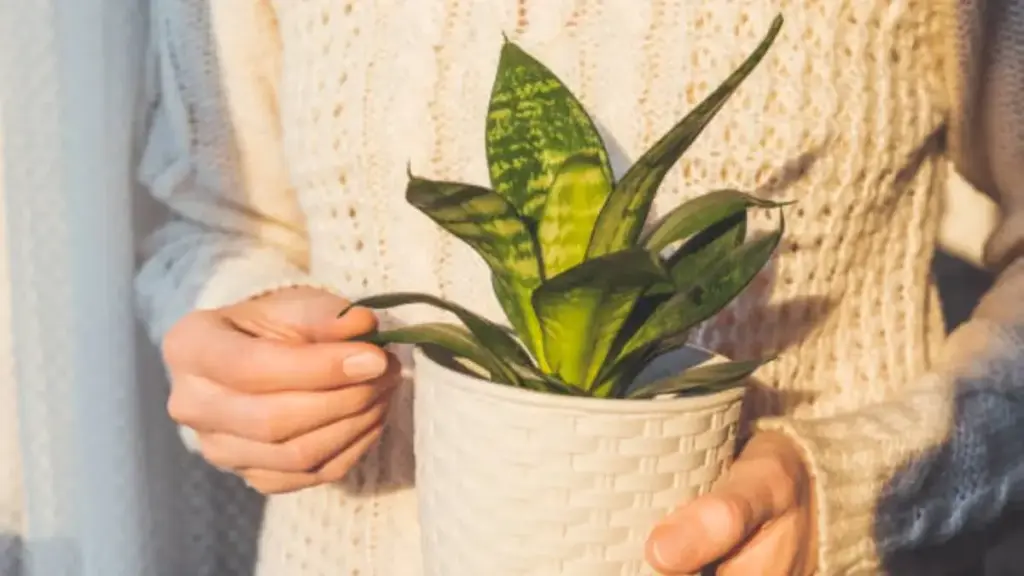
2. 🌡️ Temperature and Humidity
Warm temperatures accelerate evaporation from the soil, while cooler conditions significantly slow the process down. Snake plants in warm rooms (21–27°C / 70–80°F) will dry out faster than those in cooler rooms below 18°C / 65°F.
Low humidity, such as in heated indoor spaces during winter, also causes soil to dry quickly. High humidity, such as in bathrooms or kitchens, keeps soil moist for longer.
3. 💧 Soil Type and Drainage
Well‑draining soil helps prevent excess moisture from lingering around the roots. A gritty mix, such as a cactus or succulent blend, dries quickly and reduces the risk of rot.
Dense, moisture‑retentive soil stays wet longer and requires less frequent watering. Adding perlite or pumice can improve drainage in heavy soil.
4. 🏺 Pot Material and Size
The type and size of the pot influence how quickly soil dries. Terracotta pots absorb moisture from the soil, which helps it dry out more quickly. Plastic or glazed ceramic pots are non‑porous and hold water longer.
Smaller pots dry out more quickly than larger ones. Choosing the right pot is key to maintaining healthy soil moisture for your plant.
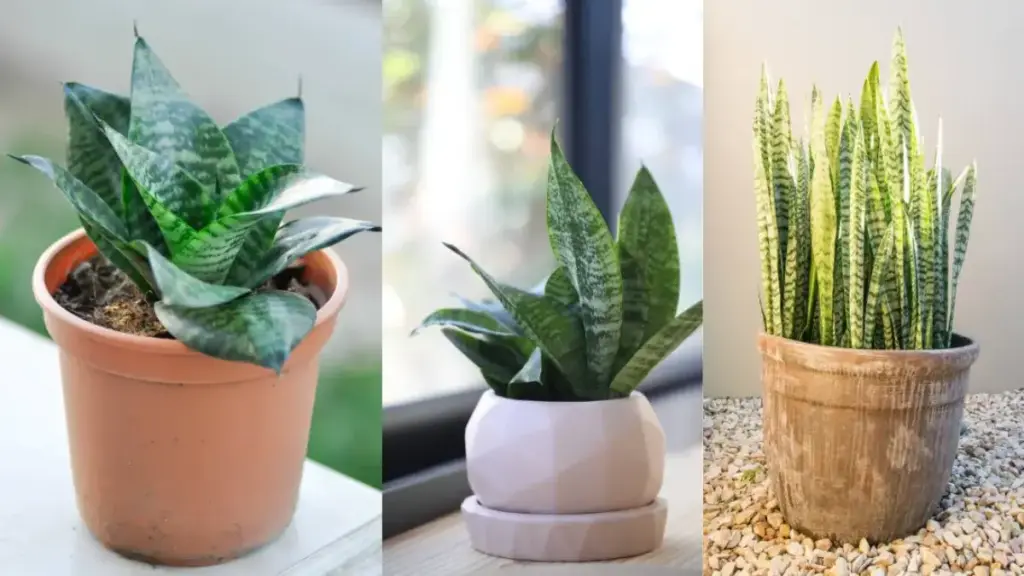
5. 🏠 Indoor vs. Outdoor Growing
Snake plants grown indoors experience more stable conditions and slower soil drying. Outdoor plants are exposed to wind, sun, and heat, which can dry soil in a matter of days.
Outdoor plants in summer may need water twice as often as indoor ones.
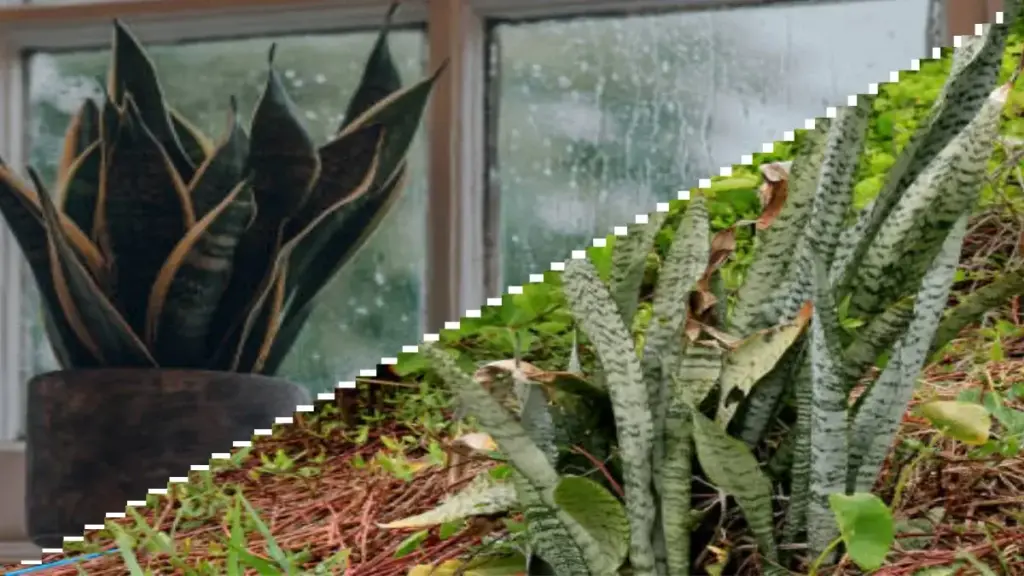
6. 🌎 Climate and Region
Local climate sets the baseline for watering needs. Hot, dry climates cause faster evaporation and require more frequent watering. Cool, humid climates slow drying and reduce watering frequency.
When moving plants between regions or seasons, allow a week for them to adjust before changing the watering schedule.
How Snake Plants Store Water (and Why Overwatering is a Risk)
Snake plants are adapted to survive in dry, drought-prone environments. They store water in their thick, upright leaves, which act as reservoirs that can sustain the plant for weeks without rainfall. Beneath the soil, rhizomes store both water and nutrients, providing an additional reserve during prolonged dry periods.
According to Arizona State University, these plants use a form of photosynthesis known as Crassulacean Acid Metabolism (CAM), which allows them to open their stomata at night instead of during the day. This adaptation reduces water loss in hot, sunny conditions and helps them thrive where many other plants would wilt.
In their native West African habitat, snake plants grow in sandy, fast‑draining soils under intense sun, where they must endure long stretches without rain.
Because they are so efficient at storing water, snake plants are more susceptible to root rot than many other tropical plants. Excess moisture in the soil can quickly lead to oxygen deprivation in the roots, making overwatering the most common cause of decline.
Signs Your Snake Plant Needs Water (Underwatered)
Although snake plants are drought‑tolerant, they can still become underwatered, especially in bright light or warm, dry conditions. If you notice any of the following signs, water the plant thoroughly and monitor its condition:
- Wrinkled or curling leaves
- Brown, crispy leaf tips
- The soil has shrunk and separated from the sides of the pot.
- Slowed or stunted growth
If the soil is extremely dry and compacted, repotting into fresh, well‑draining soil may be necessary. In most cases, a few regular waterings will restore the plant’s health.
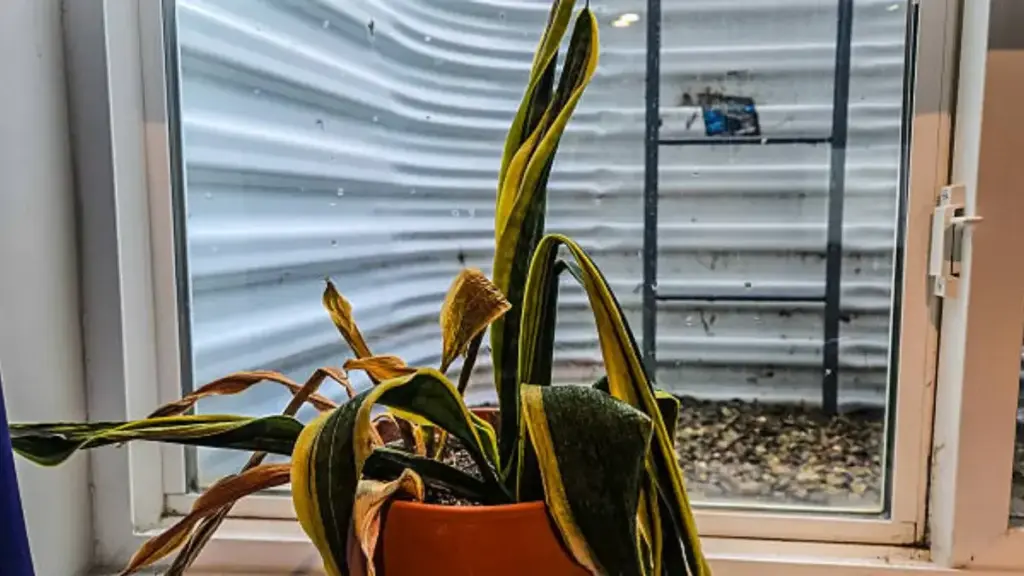
Signs Your Snake Plant is Overwatered
According to Agricultural Science 2022 review, plants under constant moisture (vs intermittent dry periods) show higher risk of root damage and reduced capacity to adjust osmotically. This supports allowing soil to dry before watering.
I once mistook drooping leaves for lack of water — but soil was soggy, pot didn’t drain. Removing rotten roots and letting soil dry fixed it.
Watch for these signs:
- Yellowing leaves, often starting at the base
- Mushy or soft leaves
- Collapsed stems
- Soggy or foul‑smelling soil
- Fungus gnats or mold on the soil surface
When overwatering is suspected, stop watering until the potting mix has dried through.
Next, remove the plant from its pot and inspect the roots. Healthy roots are firm and white, while rotting roots are brown or black and soft.
Trim away any damaged roots, then repot in fresh, well‑draining soil and a container with drainage holes.
Finally, adjust your watering schedule to ensure the top two inches of soil are dry before watering again.
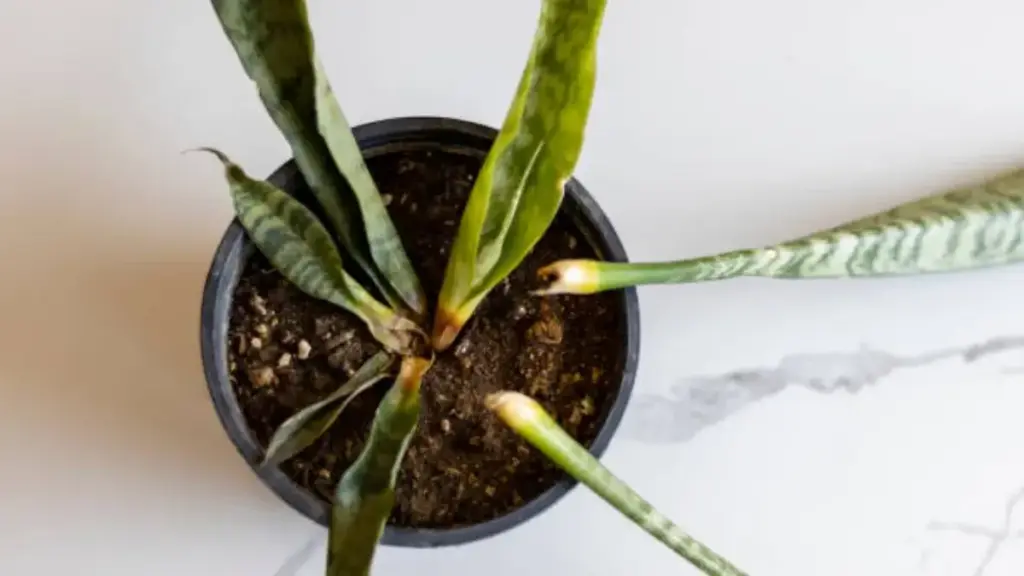
Common Watering Mistakes to Avoid
Even the toughest plants have their limits — and snake plants are no exception. Avoid these common pitfalls to keep yours thriving for years.
- Ignoring Environmental Changes Changes in light, temperature, or humidity can alter how quickly soil dries. Fix: Re‑check soil moisture after moving the plant or changing its environment.
- Overwatering This is the primary cause of decline in snake plants. They require less frequent watering than many other common houseplants. Fix: Check the top 2 inches of soil before watering. If it is damp, wait. When my plant was overwatered, I removed it from its pot, trimmed off mushy roots, repotted in fast-draining mix, and held off watering for ten days. New leaf growth followed after two weeks
- Following a Fixed Schedule Watering on a set day each week does not account for seasonal or environmental changes. Snake plants dry out at different rates depending on conditions. Fix: Base watering on soil dryness and seasonal changes rather than a fixed date. Refer to the seasonal guide above for typical frequencies, but always check the soil first.
- Poor Drainage Even correct watering can cause problems if the soil or pot retains too much moisture. Fix: Use a well‑draining succulent mix and a pot with drainage holes. Terracotta pots help moisture evaporate more quickly.
- Using Cold Water Very cold water can shock the roots, especially in cooler months. Fix: Use room‑temperature or slightly lukewarm water.
- Watering the Leaves Instead of the Soil Water trapped in the leaf rosette can lead to rot. Fix: Apply water directly to the soil around the base of the plant.
FAQs
-
How do I tell if my snake plant needs water?
Stick your finger in the soil 2 inches deep—if it’s bone dry, it’s time to water. Look for wrinkling or drooping leaves too.
-
Can I water my snake plant once a month?
Yes! Especially in winter. If the soil feels bone dry, watering once a month is totally okay—especially during winter rest periods.
-
Do I water snake plants from the top or bottom?
Top watering is best for flushing the soil, but bottom watering works for compacted soil.
-
Can I use ice cubes to water a snake plant?
Nope! Ice water can shock the roots. Always use lukewarm or room-temp water.
-
Can I mist my snake plant instead of watering?
Nope. Misting won’t hydrate the roots. Snake plants don’t need high humidity—they just want occasional deep watering.
-
Is rainwater good for snake plants?
Yes, rainwater is excellent because it’s soft and free of salts or chemicals found in tap water.
-
Is coffee water good for snake plants?
No. Coffee water is acidic and can harm snake plant roots. Use plain water or diluted organic fertilizer instead.
-
How long can snake plants go without water?
They can survive 6–8 weeks without water, especially in cooler or darker rooms.
Final Tips for Perfect Snake Plant Watering
Snake plants may be low‑maintenance, but the right watering habits will keep them looking sculptural and healthy for years. Here’s your quick takeaway:
- Check the soil, not the calendar — water only when the top 2 inches are bone dry.
- Adjust for the season — more often in warm, bright months, less in cool, low‑light months.
- Factor in environment — light, temperature, humidity, pot type, and soil all change how fast water evaporates.
- When in doubt, wait it out — snake plants handle drought far better than soggy roots.
Remember: Every home is different. Your plant’s perfect schedule is the one that matches its light, pot, and soil — not someone else’s timetable.
Keep Growing Your Snake Plant Skills
- How to Care for Snake Plant — a complete guide to light, soil, and propagation.
- Best Soil for Snake Plants — create the perfect fast‑draining mix.
- Snake Plant Winter Care — protect your plant during its slow season.
- Best Pot for Snake Plant — choose the ideal container for healthy roots.
